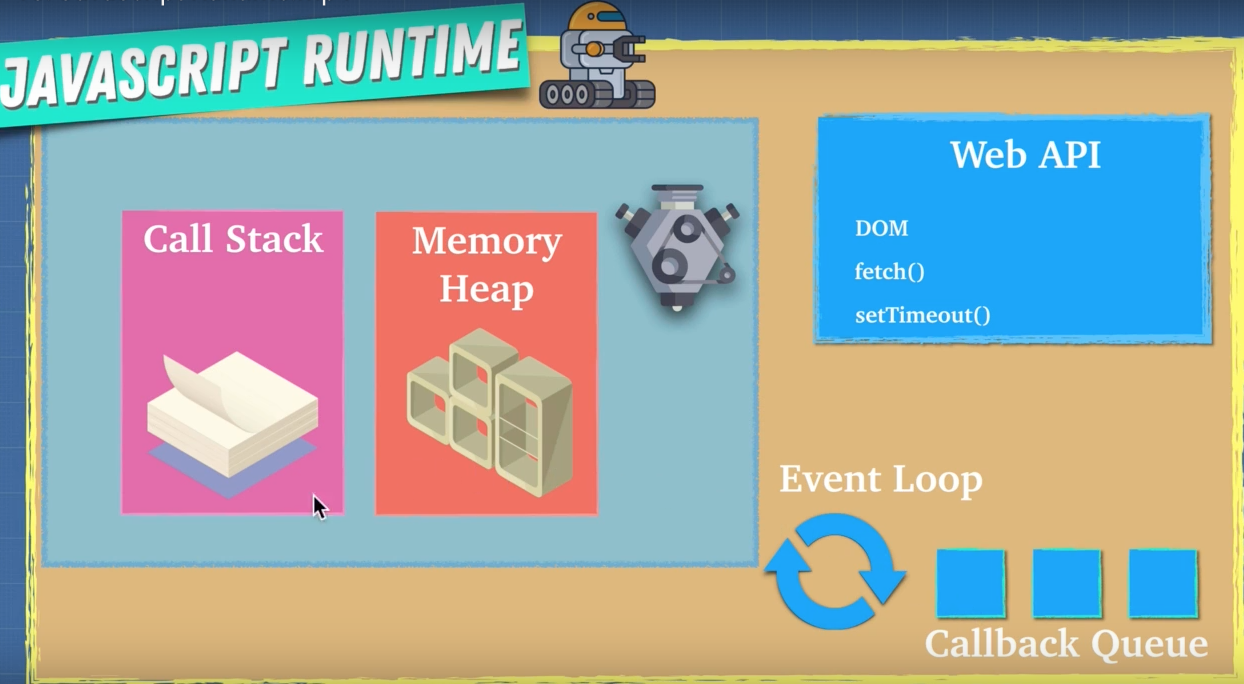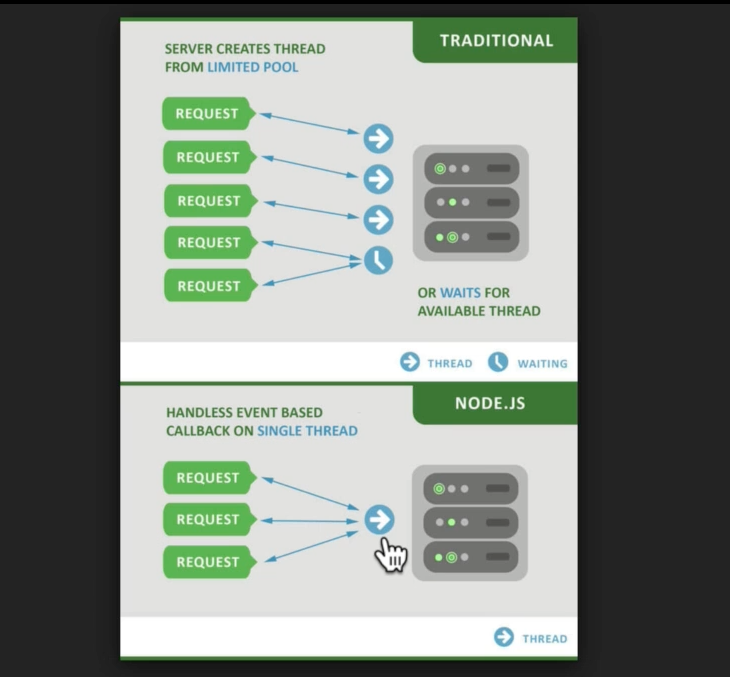-
-
Save yogain123/6374decfc71d648eeb3c4a4052a9789c to your computer and use it in GitHub Desktop.
| hola |
JavaScript Runtime
When Web API is ready with Response, it goes to the callback queue, and says I am the 1st person that is done, can u take my response. Event Loop is a loop that constantly checking says hey Is CallStack Empty?, Is CallStack Empty?, Is CallStack Empty? and Once CallStack is empty and entire JS file has been read then the event loop runs and put WebApi Response to CallStack.
So what is NodeJs?
NodeJS is not a language, Its a JS Runtime
Higher Order Function
Function that returns a function is HOF example: Closure
Array To Object
let arr = [1,2,3,4,5]
let obj = {...arr}
console.log(obj) // {0: 1, 1: 2, 2: 3, 3: 4, 4: 5}
Quantifiers +, *, ? and {n}
Let’s say we have a string like +7(903)-123-45-67 and want to find all numbers in it. But unlike before, we are interested not in single digits, but full numbers: 7, 903, 123, 45, 67.
A number is a sequence of 1 or more digits \d. To mark how many we need, we can append a quantifier.
Methods of RegExp and String
- str.match(regexp)
- str.split(regexp|substr, limit)
- str.search(regexp)
- str.replace(str|regexp, str|func)
- regexp.exec(str)
- regexp.test(str)
JS 2020 features
console.log(obj.name ?? "yogendra"); // ?? same as || but only takes null, undefined as false value
console.log(obj?.name?.firstName)
Promise.allSettled([p1. p2])
console.log(globalThis) == console.log(self) == console.log(window) == console.log(global)
now globalThis is common for both browser and node
Getter and Setter in JS
What makes them special is that we don't access data as a function. We access it just like we would any old property
- You can check if new data is valid before setting a property
- You can perform an action on the data which you are getting or setting on a property.
- You can control which properties can be stored and retrieved.
var shout = {
_message: "HELLO!",
get message() {
return this._message;
},
set message(value) {
this._message = value.toUpperCase();
}
};
shout.message = "This is sparta!";
console.log(shout.message); // THIS IS SPARTA!
//================================================================
class Person{
constructor(){
this._message= "HELLO!"
}
get message() {
return this._message;
}
set message(value) {
this._message = value.toUpperCase()+" LOL";
}
}
let p = new Person();
p.message = "this is sparta!";
console.log(p.message); // THIS IS SPARTA! LOL
prototypal chaining
let arr = [1,2,3,4];
let obj = {}
let fn = ()=>2;
console.log(arr.__proto__.__proto__)
console.log(obj.__proto__)
console.log(fn.__proto__.__proto__)
console.log(Function.prototype.__proto__)
console.log(Array.prototype.__proto__)
console.log(Object.prototype)
All is same
Promise Catching at the place
let p1 = new Promise((resolve, reject) => {
resolve("done1")
});
let p2 = new Promise((resolve, reject) => {
resolve("done2");
})
let p3 = new Promise((resolve, reject) => {
reject("reject3")
}).catch((error) => { // catching error directly here so that in Promise.all it is considered as successs
return undefined;
});
Promise.all([p1,p2,p3]).then(res=>{
console.log({res}); // { res: [ 'done1', 'done2', undefined ] }
}).catch((error) => {
console.log({error});
})
what is output
var foo = 'bim'
var getFoo = function () { return foo }
foo = 'boum'
console.log(getFoo()); // boum
The answer is ‘boum’ because foo is changed to ‘boum’ on line 3, and function getFoo will return a variable foo within its scope.
Output
In the following code, I expected both a and b to be 3. However, a is undefined and b is 3. Why?
(function(){
var a = b = 3;
})();
console.log(typeof a);//"undefined"
console.log(b);//3
Actually it is
var a = 3;
b = 3
b = 3 is an assignment without a declaration. Since there is no b in the current execution context (the IIFE), JavaScript engine looks for b in the outer lexical environment. In this case, the outer environment is the global execution context.
Since b is not found in the global execution context either, and assuming non-strict mode, JavaScript implicitly creates b as a property of the global object (e.g., window.b in browsers). This makes b a global variable.
Prototype
class Hola{
constructor(){
this.name="yogendra";
console.log(this);
}
static div(){
console.log("div");
}
sum(){
console.log("sum");
}
}
const h = new Hola();
console.log(Object.getPrototypeOf(h)) // {constructor: ƒ, sum: ƒ}
console.log(h.__proto__) // {constructor: ƒ, sum: ƒ}
console.log(Hola.prototype); // {constructor: ƒ, sum: ƒ}
Array.at()
Get the value at that position -> index passed
const arr = ["jack","yogi","abc"]
console.log(arr.at(0)) // "jack"
console.log(arr.at(-1)) // "abc"
This keyword
Akshay -> https://www.youtube.com/watch?v=9T4z98JcHR0&list=PLlasXeu85E9eWOpw9jxHOQyGMRiBZ60aX&index=9





































CallStack and Memory Heap
Memory Heap ==> Allocate Memory, Use memory and Release memory
CallStack ==> with this we keep track of where we are in code so with that we can run the code in order (LIFO)
Stack Overflow
Maximum Call Stack Size Exceeded